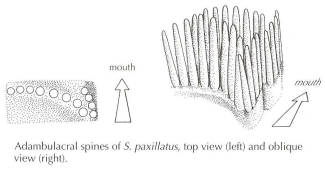Solaster paxillatus has 8 to 10 arms up to 19 cm long. The arms are broad at the base, narrowing rapidly to the tip. The body is orange aborally and yellow orally. A specimen off Oregon at 457 metres was violet on both sides. Viewed from above, the marginals create a serrated edge, just as in S. dawsoni, but the arrangement of the adambulacral spines will separate these two species. The ratio of arm to disc is from 3.0 to 3.7. The aboral pseudopaxillae are evenly spaced and each bears a crown of numerous fine spinelets about as long as the pseudopaxilla is high. Between each arm there is often a suggestion of a bare streak. On dried specimens the aboral skeleton forms a squarish or diamond-shaped mesh with a pseudopaxilla at each junction of the mesh. The papulae occur in groups of 1 to 12. About 60 large fan-shaped inferomarginals create a serrated edge to the arm. Superomarginals are about the same size as the largest aboral pseudopaxilla and situated just above and between each inferomarginal. The oral interradial area contains numerous pseudopaxillae topped with a compact cluster of spinelets slightly longer than the base of the pseudopaxilla. The adambulacrals are similar in general appearance to those of S. dawsoni, with 4 furrow spines reducing to 1 distally, and on the oral surface of the plate, a curved transverse series of 5 to 8 long slender spines only slightly longer than the furrow spines. The proximal spine of the transverse series meets the distal spine of the furrow series. The mouth plates are large and shovel-like with 8 to 11 webbed marginal spines and up to 20 finer suboral spines.
Characteristics
Similar SpeciesSolaster paxillatus differs from other Solaster species in body proportions and adambulacral spines.
